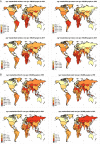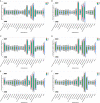Global, regional, and national burden of cardiovascular diseases in youths and young adults aged 15-39 years in 204 countries/territories, 1990-2019: a systematic analysis of Global Burden of Disease Study 2019
- PMID: 37365627
- PMCID: PMC10294522
- DOI: 10.1186/s12916-023-02925-4
Global, regional, and national burden of cardiovascular diseases in youths and young adults aged 15-39 years in 204 countries/territories, 1990-2019: a systematic analysis of Global Burden of Disease Study 2019
Abstract
Background: Understanding the temporal trends in the burden of overall and type-specific cardiovascular diseases (CVDs) in youths and young adults and its attributable risk factors is important for effective and targeted prevention strategies and measures. We aimed to provide a standardized and comprehensive estimation of the prevalence, incidence, disability-adjusted life years (DALY), and mortality rate of CVDs and its associated risk factors in youths and young adults aged 15-39 years at global, regional, and national levels.
Methods: We applied Global Burden of Disease, Injuries, and Risk Factors Study (GBD) 2019 analytical tools to calculate the age-standardized incidence, prevalence, DALY, and mortality rate of overall and type-specific CVDs (i.e., rheumatic heart disease, ischemic heart disease, stroke, hypertensive heart disease, non-rheumatic valvular heart disease, cardiomyopathy and myocarditis, atrial fibrillation and flutter, aortic aneurysm, and endocarditis) among youths and young adults aged 15-39 years by age, sex, region, sociodemographic index and across 204 countries/territories from 1990 to 2019, and proportional DALY of CVDs attributable to associated risk factors.
Results: The global age-standardized DALY (per 100,000 population) for CVDs in youths and young adults significantly decreased from 1257.51 (95% confidence interval 1257.03, 1257.99) in 1990 to 990.64 (990.28, 990.99) in 2019 with an average annual percent change (AAPC) of - 0.81% (- 1.04%, - 0.58%, P < 0.001), and the age-standardized mortality rate also significantly decreased from 19.83 (19.77, 19.89) to 15.12 (15.08, 15.16) with an AAPC of - 0.93% (- 1.21%, - 0.66%, P < 0.001). However, the global age-standardized incidence rate (per 100,000 population) moderately increased from 126.80 (126.65, 126.95) in 1990 to 129.85 (129.72, 129.98) in 2019 with an AAPC of 0.08% (0.00%, 0.16%, P = 0.040), and the age-standardized prevalence rate significantly increased from 1477.54 (1477.03, 1478.06) to 1645.32 (1644.86, 1645.78) with an AAPC of 0.38% (0.35%, 0.40%, P < 0.001). In terms of type-specific CVDs, the age-standardized incidence and prevalence rate in rheumatic heart disease, prevalence rate in ischemic heart disease, and incidence rate in endocarditis increased from 1990 to 2019 (all P < 0.001). When stratified by sociodemographic index (SDI), the countries/territories with low and low-middle SDI had a higher burden of CVDs than the countries/territories with high and high-middle SDI. Women had a higher prevalence rate of CVDs than men, whereas men had a higher DALY and mortality rate than women. High systolic blood pressure, high body mass index, and low-density lipoprotein cholesterol were the main attributable risk factors for DALY of CVDs for all included countries and territories. Household air pollution from solid fuels was an additional attributable risk factor for DALY of CVDs in low and low-middle SDI countries compared with middle, high-middle, and high SDI countries. Compared with women, DALY for CVDs in men was more likely to be affected by almost all risk factors, especially for smoking.
Conclusions: There is a substantial global burden of CVDs in youths and young adults in 2019. The burden of overall and type-specific CVDs varied by age, sex, SDI, region, and country. CVDs in young people are largely preventable, which deserve more attention in the targeted implementation of effective primary prevention strategies and expansion of young-people's responsive healthcare systems.
Keywords: Cardiovascular disease; Global; Young adults; Youths.
© 2023. The Author(s).
Conflict of interest statement
The authors declare that they have no competing interests. Bo Xi is a member of the BMC Medicine editorial board. None of the authors, including Bo Xi, had a role in the peer review or handling of this manuscript. The authors, other than Bo Xi, declare that they have no competing interests.
Figures






Comment in
-
Cardiovascular disease prevention should start in early life.BMC Glob Public Health. 2023 Sep 7;1(1):14. doi: 10.1186/s44263-023-00015-4. BMC Glob Public Health. 2023. PMID: 39681909 Free PMC article.
References
-
- Yusuf S, Joseph P, Rangarajan S, Islam S, Mente A, Hystad P, et al. Modifiable risk factors, cardiovascular disease, and mortality in 155 722 individuals from 21 high-income, middle-income, and low-income countries (PURE): a prospective cohort study. Lancet. 2020;395(10226):795–808. doi: 10.1016/S0140-6736(19)32008-2. - DOI - PMC - PubMed
-
- World Health Organization and World Economic Forum. From burden to “best buys”: reducing the economic impact of non-communicable diseases in low- and middle-income countries. Geneva, Switzerland: World Health Organization and World Economic Forum: 2011.https://www.researchgate.net/profile/Klaus-Prettner/publication/25441757....
Publication types
MeSH terms
LinkOut - more resources
Full Text Sources

